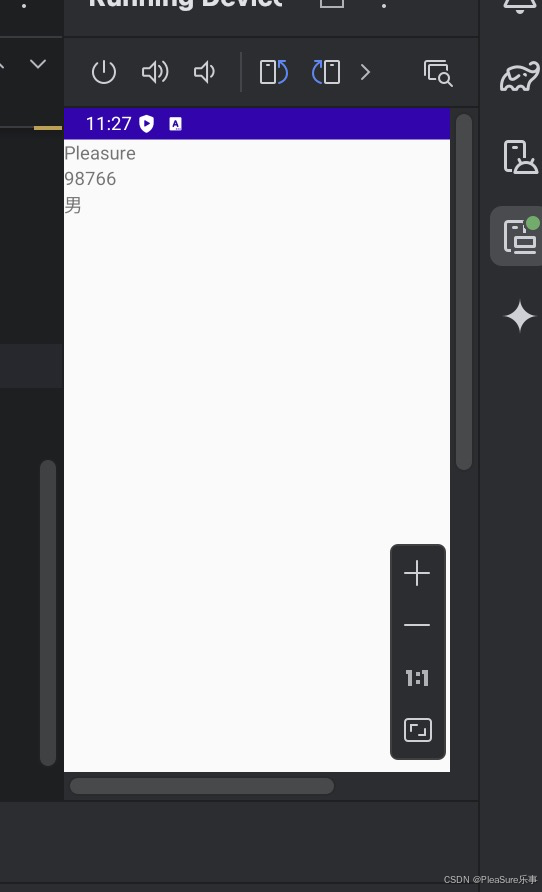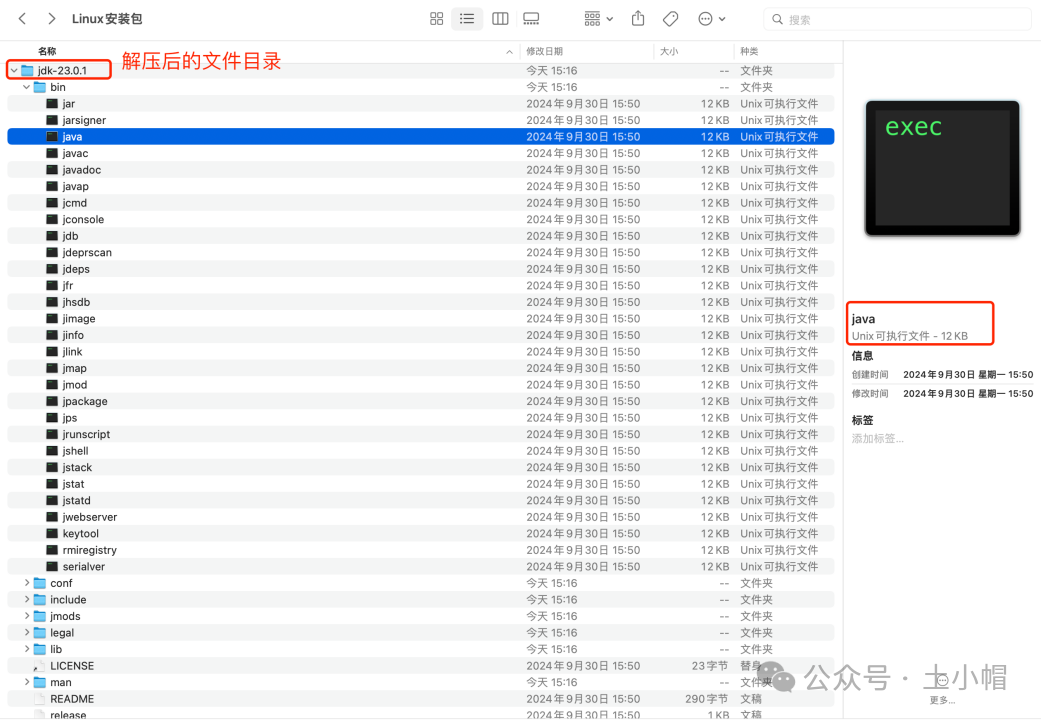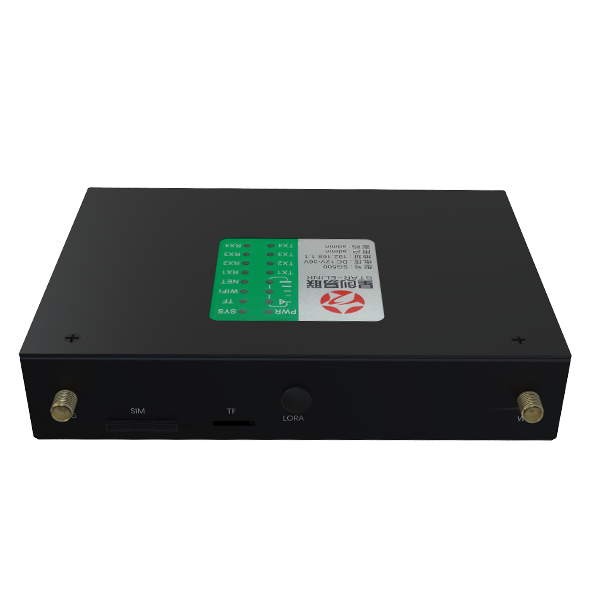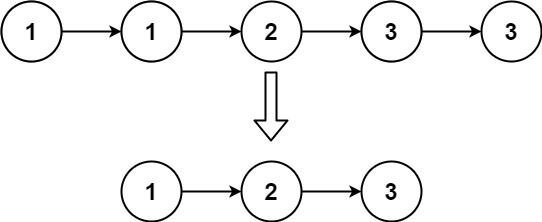一. AVFrame 核心回顾,uint8_t *data[AV_NUM_DATA_POINTERS] 和 int linesize[AV_NUM_DATA_POINTERS]
AVFrame 存储的是解码后的数据,(包括音频和视频)例如:yuv数据,或者pcm数据,参考AVFrame结构体的第一句话。
其核心数据为:
AV_NUM_DATA_POINTERS = 8;
uint8_t *data[AV_NUM_DATA_POINTERS];
int linesize[AV_NUM_DATA_POINTERS];
uint8_t *data[AV_NUM_DATA_POINTERS];
data -->xxxxxxxxxxxxxxxxxxxxxxxxxxxxxxxxxxxxxxxxxxxxx
^ ^ ^
| | |
data[0] data[1] data[2]
比如说,当pix_fmt=AV_PIX_FMT_YUV420P时,data中的数据是按照YUV的格式存储的,也就是:
data -->YYYYYYYYYYYYYYYYYYYYYYYYUUUUUUUUUUUVVVVVVVVVVVV
^ ^ ^
| | |
data[0] data[1] data[2]
int linesize[AV_NUM_DATA_POINTERS];
linesize是指对应于每一行的大小,为什么需要这个变量,是因为在YUV格式和RGB格式时,每行的大小不一定等于图像的宽度。
linesize = width + padding size(16+16) for YUV
linesize = width*pixel_size for RGB
padding is needed during Motion Estimation and Motion Compensation for Optimizing MV serach and P/B frame reconstruction
for RGB only one channel is available
so RGB24 : data[0] = packet rgbrgbrgbrgb......
linesize[0] = width*3
data[1],data[2],data[3],linesize[1],linesize[2],linesize[2] have no any means for RGB
在二核心函数中 关于linesize[x]字节数的验证 代码,可以参考
/**
* This structure describes decoded (raw) audio or video data.
*
* AVFrame must be allocated using av_frame_alloc(). Note that this only
* allocates the AVFrame itself, the buffers for the data must be managed
* through other means (see below).
* AVFrame must be freed with av_frame_free().
*
* AVFrame is typically allocated once and then reused multiple times to hold
* different data (e.g. a single AVFrame to hold frames received from a
* decoder). In such a case, av_frame_unref() will free any references held by
* the frame and reset it to its original clean state before it
* is reused again.
*
* The data described by an AVFrame is usually reference counted through the
* AVBuffer API. The underlying buffer references are stored in AVFrame.buf /
* AVFrame.extended_buf. An AVFrame is considered to be reference counted if at
* least one reference is set, i.e. if AVFrame.buf[0] != NULL. In such a case,
* every single data plane must be contained in one of the buffers in
* AVFrame.buf or AVFrame.extended_buf.
* There may be a single buffer for all the data, or one separate buffer for
* each plane, or anything in between.
*
* sizeof(AVFrame) is not a part of the public ABI, so new fields may be added
* to the end with a minor bump.
*
* Fields can be accessed through AVOptions, the name string used, matches the
* C structure field name for fields accessible through AVOptions. The AVClass
* for AVFrame can be obtained from avcodec_get_frame_class()
*/
typedef struct AVFrame {
#define AV_NUM_DATA_POINTERS 8
/**
* pointer to the picture/channel planes.
* This might be different from the first allocated byte. For video,
* it could even point to the end of the image data.
*
* All pointers in data and extended_data must point into one of the
* AVBufferRef in buf or extended_buf.
*
* Some decoders access areas outside 0,0 - width,height, please
* see avcodec_align_dimensions2(). Some filters and swscale can read
* up to 16 bytes beyond the planes, if these filters are to be used,
* then 16 extra bytes must be allocated.
*
* NOTE: Pointers not needed by the format MUST be set to NULL.
*
* @attention In case of video, the data[] pointers can point to the
* end of image data in order to reverse line order, when used in
* combination with negative values in the linesize[] array.
*/
uint8_t *data[AV_NUM_DATA_POINTERS];
/**
* For video, a positive or negative value, which is typically indicating
* the size in bytes of each picture line, but it can also be:
* - the negative byte size of lines for vertical flipping
* (with data[n] pointing to the end of the data
* - a positive or negative multiple of the byte size as for accessing
* even and odd fields of a frame (possibly flipped)
*
* For audio, only linesize[0] may be set. For planar audio, each channel
* plane must be the same size.
*
* For video the linesizes should be multiples of the CPUs alignment
* preference, this is 16 or 32 for modern desktop CPUs.
* Some code requires such alignment other code can be slower without
* correct alignment, for yet other it makes no difference.
*
* @note The linesize may be larger than the size of usable data -- there
* may be extra padding present for performance reasons.
*
* @attention In case of video, line size values can be negative to achieve
* a vertically inverted iteration over image lines.
*/
int linesize[AV_NUM_DATA_POINTERS];
/**
* pointers to the data planes/channels.
*
* For video, this should simply point to data[].
*
* For planar audio, each channel has a separate data pointer, and
* linesize[0] contains the size of each channel buffer.
* For packed audio, there is just one data pointer, and linesize[0]
* contains the total size of the buffer for all channels.
*
* Note: Both data and extended_data should always be set in a valid frame,
* but for planar audio with more channels that can fit in data,
* extended_data must be used in order to access all channels.
*/
uint8_t **extended_data;
/**
* @name Video dimensions
* Video frames only. The coded dimensions (in pixels) of the video frame,
* i.e. the size of the rectangle that contains some well-defined values.
*
* @note The part of the frame intended for display/presentation is further
* restricted by the @ref cropping "Cropping rectangle".
* @{
*/
int width, height;
/**
* @}
*/
/**
* number of audio samples (per channel) described by this frame
*/
int nb_samples;
/**
* format of the frame, -1 if unknown or unset
* Values correspond to enum AVPixelFormat for video frames,
* enum AVSampleFormat for audio)
*/
int format;
/**
* 1 -> keyframe, 0-> not
*/
int key_frame;
/**
* Picture type of the frame.
*/
enum AVPictureType pict_type;
/**
* Sample aspect ratio for the video frame, 0/1 if unknown/unspecified.
*/
AVRational sample_aspect_ratio;
/**
* Presentation timestamp in time_base units (time when frame should be shown to user).
*/
int64_t pts;
/**
* DTS copied from the AVPacket that triggered returning this frame. (if frame threading isn't used)
* This is also the Presentation time of this AVFrame calculated from
* only AVPacket.dts values without pts values.
*/
int64_t pkt_dts;
/**
* Time base for the timestamps in this frame.
* In the future, this field may be set on frames output by decoders or
* filters, but its value will be by default ignored on input to encoders
* or filters.
*/
AVRational time_base;
#if FF_API_FRAME_PICTURE_NUMBER
/**
* picture number in bitstream order
*/
attribute_deprecated
int coded_picture_number;
/**
* picture number in display order
*/
attribute_deprecated
int display_picture_number;
#endif
/**
* quality (between 1 (good) and FF_LAMBDA_MAX (bad))
*/
int quality;
/**
* for some private data of the user
*/
void *opaque;
/**
* When decoding, this signals how much the picture must be delayed.
* extra_delay = repeat_pict / (2*fps)
*/
int repeat_pict;
/**
* The content of the picture is interlaced.
*/
int interlaced_frame;
/**
* If the content is interlaced, is top field displayed first.
*/
int top_field_first;
/**
* Tell user application that palette has changed from previous frame.
*/
int palette_has_changed;
#if FF_API_REORDERED_OPAQUE
/**
* reordered opaque 64 bits (generally an integer or a double precision float
* PTS but can be anything).
* The user sets AVCodecContext.reordered_opaque to represent the input at
* that time,
* the decoder reorders values as needed and sets AVFrame.reordered_opaque
* to exactly one of the values provided by the user through AVCodecContext.reordered_opaque
*
* @deprecated Use AV_CODEC_FLAG_COPY_OPAQUE instead
*/
attribute_deprecated
int64_t reordered_opaque;
#endif
/**
* Sample rate of the audio data.
*/
int sample_rate;
#if FF_API_OLD_CHANNEL_LAYOUT
/**
* Channel layout of the audio data.
* @deprecated use ch_layout instead
*/
attribute_deprecated
uint64_t channel_layout;
#endif
/**
* AVBuffer references backing the data for this frame. All the pointers in
* data and extended_data must point inside one of the buffers in buf or
* extended_buf. This array must be filled contiguously -- if buf[i] is
* non-NULL then buf[j] must also be non-NULL for all j < i.
*
* There may be at most one AVBuffer per data plane, so for video this array
* always contains all the references. For planar audio with more than
* AV_NUM_DATA_POINTERS channels, there may be more buffers than can fit in
* this array. Then the extra AVBufferRef pointers are stored in the
* extended_buf array.
*/
AVBufferRef *buf[AV_NUM_DATA_POINTERS];
/**
* For planar audio which requires more than AV_NUM_DATA_POINTERS
* AVBufferRef pointers, this array will hold all the references which
* cannot fit into AVFrame.buf.
*
* Note that this is different from AVFrame.extended_data, which always
* contains all the pointers. This array only contains the extra pointers,
* which cannot fit into AVFrame.buf.
*
* This array is always allocated using av_malloc() by whoever constructs
* the frame. It is freed in av_frame_unref().
*/
AVBufferRef **extended_buf;
/**
* Number of elements in extended_buf.
*/
int nb_extended_buf;
AVFrameSideData **side_data;
int nb_side_data;
/**
* @defgroup lavu_frame_flags AV_FRAME_FLAGS
* @ingroup lavu_frame
* Flags describing additional frame properties.
*
* @{
*/
/**
* The frame data may be corrupted, e.g. due to decoding errors.
*/
#define AV_FRAME_FLAG_CORRUPT (1 << 0)
/**
* A flag to mark the frames which need to be decoded, but shouldn't be output.
*/
#define AV_FRAME_FLAG_DISCARD (1 << 2)
/**
* @}
*/
/**
* Frame flags, a combination of @ref lavu_frame_flags
*/
int flags;
/**
* MPEG vs JPEG YUV range.
* - encoding: Set by user
* - decoding: Set by libavcodec
*/
enum AVColorRange color_range;
enum AVColorPrimaries color_primaries;
enum AVColorTransferCharacteristic color_trc;
/**
* YUV colorspace type.
* - encoding: Set by user
* - decoding: Set by libavcodec
*/
enum AVColorSpace colorspace;
enum AVChromaLocation chroma_location;
/**
* frame timestamp estimated using various heuristics, in stream time base
* - encoding: unused
* - decoding: set by libavcodec, read by user.
*/
int64_t best_effort_timestamp;
/**
* reordered pos from the last AVPacket that has been input into the decoder
* - encoding: unused
* - decoding: Read by user.
*/
int64_t pkt_pos;
#if FF_API_PKT_DURATION
/**
* duration of the corresponding packet, expressed in
* AVStream->time_base units, 0 if unknown.
* - encoding: unused
* - decoding: Read by user.
*
* @deprecated use duration instead
*/
attribute_deprecated
int64_t pkt_duration;
#endif
/**
* metadata.
* - encoding: Set by user.
* - decoding: Set by libavcodec.
*/
AVDictionary *metadata;
/**
* decode error flags of the frame, set to a combination of
* FF_DECODE_ERROR_xxx flags if the decoder produced a frame, but there
* were errors during the decoding.
* - encoding: unused
* - decoding: set by libavcodec, read by user.
*/
int decode_error_flags;
#define FF_DECODE_ERROR_INVALID_BITSTREAM 1
#define FF_DECODE_ERROR_MISSING_REFERENCE 2
#define FF_DECODE_ERROR_CONCEALMENT_ACTIVE 4
#define FF_DECODE_ERROR_DECODE_SLICES 8
#if FF_API_OLD_CHANNEL_LAYOUT
/**
* number of audio channels, only used for audio.
* - encoding: unused
* - decoding: Read by user.
* @deprecated use ch_layout instead
*/
attribute_deprecated
int channels;
#endif
/**
* size of the corresponding packet containing the compressed
* frame.
* It is set to a negative value if unknown.
* - encoding: unused
* - decoding: set by libavcodec, read by user.
*/
int pkt_size;
/**
* For hwaccel-format frames, this should be a reference to the
* AVHWFramesContext describing the frame.
*/
AVBufferRef *hw_frames_ctx;
/**
* AVBufferRef for free use by the API user. FFmpeg will never check the
* contents of the buffer ref. FFmpeg calls av_buffer_unref() on it when
* the frame is unreferenced. av_frame_copy_props() calls create a new
* reference with av_buffer_ref() for the target frame's opaque_ref field.
*
* This is unrelated to the opaque field, although it serves a similar
* purpose.
*/
AVBufferRef *opaque_ref;
/**
* @anchor cropping
* @name Cropping
* Video frames only. The number of pixels to discard from the the
* top/bottom/left/right border of the frame to obtain the sub-rectangle of
* the frame intended for presentation.
* @{
*/
size_t crop_top;
size_t crop_bottom;
size_t crop_left;
size_t crop_right;
/**
* @}
*/
/**
* AVBufferRef for internal use by a single libav* library.
* Must not be used to transfer data between libraries.
* Has to be NULL when ownership of the frame leaves the respective library.
*
* Code outside the FFmpeg libs should never check or change the contents of the buffer ref.
*
* FFmpeg calls av_buffer_unref() on it when the frame is unreferenced.
* av_frame_copy_props() calls create a new reference with av_buffer_ref()
* for the target frame's private_ref field.
*/
AVBufferRef *private_ref;
/**
* Channel layout of the audio data.
*/
AVChannelLayout ch_layout;
/**
* Duration of the frame, in the same units as pts. 0 if unknown.
*/
int64_t duration;
} AVFrame;二 核心函数 av_frame_alloc(),av_frame_get_buffer
AVFrame* avframe1 = av_frame_alloc();
从实现来看,av_frame_alloc 函数只是 给 avframe1分配了空间,但是内部的值都没有,也就是说avframe内部需要空间的都没有分配。

int av_frame_get_buffer(AVFrame *frame, int align);
给传递进来的 frame 的内部元素分配空间,
第一个参数:给那个frame分配空间
第二个参数:分配空间的对齐是按照 align 进行,如果填充的是0,会根据当前CPU给一个默认值,测试在32位 windows上,这个值就是32. 一般都会填写0,使用默认值
/**
* Allocate new buffer(s) for audio or video data.
*
* The following fields must be set on frame before calling this function:
* - format (pixel format for video, sample format for audio)
* - width and height for video
* - nb_samples and ch_layout for audio
*
* This function will fill AVFrame.data and AVFrame.buf arrays and, if
* necessary, allocate and fill AVFrame.extended_data and AVFrame.extended_buf.
* For planar formats, one buffer will be allocated for each plane.
*
* @warning: if frame already has been allocated, calling this function will
* leak memory. In addition, undefined behavior can occur in certain
* cases.
*
* @param frame frame in which to store the new buffers.
* @param align Required buffer size alignment. If equal to 0, alignment will be
* chosen automatically for the current CPU. It is highly
* recommended to pass 0 here unless you know what you are doing.
*
* @return 0 on success, a negative AVERROR on error.
*/
int av_frame_get_buffer(AVFrame *frame, int align);内部实现:
可以看到如果是video,则会先判断 width 和 height 是否 > 0
也就是说,我们在调用这个函数之前,如果是for video,需要保证avframe 的 width 和height 的属性有被设置过。
int av_frame_get_buffer(AVFrame *frame, int align)
{
if (frame->format < 0)
return AVERROR(EINVAL);
FF_DISABLE_DEPRECATION_WARNINGS
if (frame->width > 0 && frame->height > 0)
return get_video_buffer(frame, align);
else if (frame->nb_samples > 0 &&
(av_channel_layout_check(&frame->ch_layout)
#if FF_API_OLD_CHANNEL_LAYOUT
|| frame->channel_layout || frame->channels > 0
#endif
))
return get_audio_buffer(frame, align);
FF_ENABLE_DEPRECATION_WARNINGS
return AVERROR(EINVAL);
}那么如果我们不设置会有什么问题呢?
试一试

设置一下 width 和height 再来看一下
还是有问题:Invalid argument
void testAVframe() {
cout << avcodec_configuration() << endl;
AVFrame* avframe1 = av_frame_alloc();
cout << "debug1...." << endl;
avframe1->width = 300;
avframe1->height = 600;
int ret = 0;
ret = av_frame_get_buffer(avframe1, 0);
if (ret < 0 ) {
//如果方法失败,会返回一个 负数,可以通过 av_strerror函数打印这个具体的信息
char buf[1024] = { 0 };
av_strerror(ret, buf, sizeof(buf));
cout << buf << endl;
}
cout << "debug2......" << endl;
}那么应该再来看源码中的具体方法:get_video_buffer(frame, align);
源码在 frame.c中,我们看到 在 av_pix_fmt_desc_get(frame->format)中 返回了一个 desc,如果这个desc 为null,也会返回error。那么也就是说,这个frame->format 应该是有必要设置的,如下:
static int get_video_buffer(AVFrame *frame, int align)
{
const AVPixFmtDescriptor *desc = av_pix_fmt_desc_get(frame->format);
int ret, i, padded_height, total_size;
int plane_padding = FFMAX(16 + 16/*STRIDE_ALIGN*/, align);
ptrdiff_t linesizes[4];
size_t sizes[4];
if (!desc)
return AVERROR(EINVAL);为了验证这个问题,我们可以设置一下frame 中的 format 测试一下。发现是可以的。我们这时候再将 avframe1中的 关键数据 打印 看一下。
void testAVframe() {
cout << avcodec_configuration() << endl;
AVFrame* avframe1 = av_frame_alloc();
cout << "debug1...." << endl;
avframe1->width = 300;
avframe1->height = 600;
//设置 foramt为 AV_PIX_FMT_YUV420P,再次测试
avframe1->format = AV_PIX_FMT_YUV420P;
int ret = 0;
ret = av_frame_get_buffer(avframe1, 0);
if (ret < 0 ) {
//如果方法失败,会返回一个 负数,可以通过 av_strerror函数打印这个具体的信息
char buf[1024] = { 0 };
av_strerror(ret, buf, sizeof(buf));
cout << buf << endl;
}
cout << "debug2......" << endl;
}关于linesize[x]字节数的验证
void testAVframe() {
cout << avcodec_configuration() << endl;
AVFrame* avframe1 = av_frame_alloc();
cout << "debug1...." << endl;
//只设置 宽和高 ,av_frame_get_buffer 函数还是会报错误。
avframe1->width = 641 ;
avframe1->height = 111;
//设置 foramt为 AV_PIX_FMT_YUV420P,再次测试 就成功了
avframe1->format = AV_PIX_FMT_RGB24;
int ret = 0;
ret = av_frame_get_buffer(avframe1, 0);
if (ret < 0 ) {
//如果方法失败,会返回一个 负数,可以通过 av_strerror函数打印这个具体的信息
char buf[1024] = { 0 };
av_strerror(ret, buf, sizeof(buf));
cout << buf << endl;
}
cout << "debug2......" << endl;
// avframe1 通过 av_frame_get_buffer 函数后,打印相关数据
cout<< " 640 *111 yuv420p case , avframe1->linesize[0] = " << avframe1->linesize[0] << endl; ///640
cout << " 640 *111 yuv420p case , avframe1->linesize[1] = " << avframe1->linesize[1] << endl; ///320
cout << " 640 *111 yuv420p case , avframe1->linesize[2] = " << avframe1->linesize[2] << endl; ///320
cout << " 641 *111 yuv420p case , avframe1->linesize[0] = " << avframe1->linesize[0] << endl;///672 由于字节对齐,多了一个32字节出来
cout << " 641 *111 yuv420p case , avframe1->linesize[1] = " << avframe1->linesize[1] << endl;///352 由于字节对齐,多了一个32字节出来
cout << " 641 *111 yuv420p case , avframe1->linesize[2] = " << avframe1->linesize[2] << endl;///352 由于字节对齐,多了一个32字节出来
cout << " 640 *111 AV_PIX_FMT_RGB24 case , avframe1->linesize[0] = " << avframe1->linesize[0] << endl; //1920,这是因为640/32 是可以除尽的,因此640 * (RGB占用3个字节) = 1920
cout << " 640 *111 AV_PIX_FMT_RGB24 case , avframe1->linesize[1] = " << avframe1->linesize[1] << endl; //0
cout << " 640 *111 AV_PIX_FMT_RGB24 case , avframe1->linesize[2] = " << avframe1->linesize[2] << endl;//0
cout << " 641 *111 AV_PIX_FMT_RGB24 case , avframe1->linesize[0] = " << avframe1->linesize[0] << endl; //2016, 这是因为641/32 是不能除尽的,因此 对于 多出来的这1个像素,本来占用1*3 = 3个字节就好,但是由于需要字节对齐,实际上给这1个像素要分配32个单位,因此实际分配位 32 *3 = 96字节 96+1920 = 2016个字节
cout << " 641 *111 AV_PIX_FMT_RGB24 case , avframe1->linesize[1] = " << avframe1->linesize[1] << endl;
cout << " 641 *111 AV_PIX_FMT_RGB24 case , avframe1->linesize[2] = " << avframe1->linesize[2] << endl;
}三。核心函数 av_frame_ref() 和 av_frame_unref(AVFrame *frame); av_frame_free(AVFrame **frame); av_buffer_get_ref_count(const AVBufferRef *buf);
int av_frame_ref(AVFrame *dst, const AVFrame *src);
引用计数 +1 和 引用计数 -1
void testAVframe1() {
int ret = 0;
AVFrame* avframe1 = av_frame_alloc();
avframe1->width = 641;
avframe1->height = 111;
avframe1->format = AV_PIX_FMT_YUV420P;
ret = av_frame_get_buffer(avframe1, 0);
if (ret < 0) {
//如果方法失败,会返回一个 负数,可以通过 av_strerror函数打印这个具体的信息
char buf[1024] = { 0 };
av_strerror(ret, buf, sizeof(buf));
cout << buf << endl;
}
//这里有个疑问,这时 avframe没有放置具体的数据,为什么这个buf[0] 有值?
if (avframe1->buf[0])
{
//av_buffer_get_ref_count函数打印 引用计数 为1
cout << "frame1 ref count = " <<
av_buffer_get_ref_count(avframe1->buf[0]); // 线程安全
cout << endl;
}
AVFrame* avframe2 = av_frame_alloc();
ret = av_frame_ref(avframe2, avframe1);
if (ret <0 ) {
//如果方法失败,会返回一个 负数,可以通过 av_strerror函数打印这个具体的信息
char buf[1024] = { 0 };
av_strerror(ret, buf, sizeof(buf));
cout << buf << endl;
}
if (avframe1->buf[0])
{
//av_buffer_get_ref_count函数打印 引用计数2
cout << "frame1 ref count = " <<
av_buffer_get_ref_count(avframe1->buf[0]); // 线程安全
cout << endl;
}
if (avframe2->buf[0])
{
//av_buffer_get_ref_count函数打印 引用计数2
cout << "frame2 ref count = " <<
av_buffer_get_ref_count(avframe2->buf[0]); // 线程安全
cout << endl;
}
cout << "debug2...." << endl;
av_frame_unref(avframe2);
if (avframe1->buf[0])
{
//av_buffer_get_ref_count函数打印 引用计数1
cout << "frame111111 ref count = " <<
av_buffer_get_ref_count(avframe1->buf[0]); // 线程安全
cout << endl;
}
//到这里 只是通过 av_frame_unref(avframe2); 释放了avframe2的内部数据,但是avframe2还是存在的
if (avframe2->buf[0])
{
//走不到这一行
//av_buffer_get_ref_count函数打印 引用计数
cout << "frame222222 ref count = " <<
av_buffer_get_ref_count(avframe2->buf[0]); // 线程安全
cout << endl;
}
av_frame_free(&avframe2);
cout << "debug3...." << endl;
av_frame_free(&avframe1);
}


















